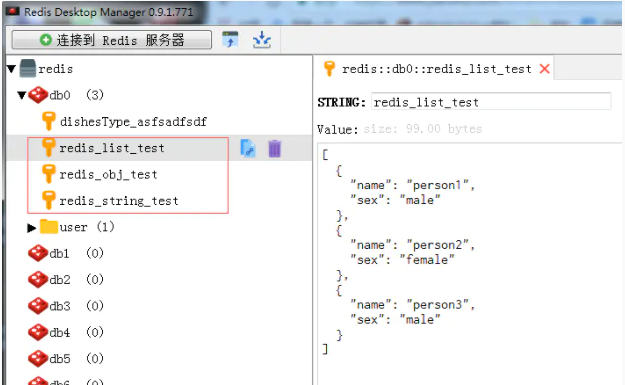Redis在項目中的使用(JedisPool方式)
springboot中redis相關配置
1、pom.xml中引入依賴
<dependency> <groupId>redis.clients</groupId> <artifactId>jedis</artifactId> <version>2.9.0</version> </dependency>
2、springboot的習慣優於配置。也在項目中使用瞭application.yml文件配置mysql的基本配置項。這裡也在application.yml裡面配置redis的配置項。
spring:
datasource:
# 驅動配置信息
url: jdbc:mysql://localhost:3306/spring_boot?useUnicode=true&characterEncoding=utf8
username: root
password: root
type: com.alibaba.druid.pool.DruidDataSource
driver-class-name: com.mysql.jdbc.Driver
# 連接池的配置信息
filters: stat
maxActive: 20
initialSize: 1
maxWait: 60000
minIdle: 1
timeBetweenEvictionRunsMillis: 60000
minEvictableIdleTimeMillis: 300000
validationQuery: select 'x'
testWhileIdle: true
testOnBorrow: false
testOnReturn: false
poolPreparedStatements: true
maxOpenPreparedStatements: 20
redis:
host: 127.0.0.1
port: 6379
password: pass1234
pool:
max-active: 100
max-idle: 10
max-wait: 100000
timeout: 0
springboot中redis相關類
- 項目操作redis是使用的RedisTemplate方式,另外還可以完全使用JedisPool和Jedis來操作redis。整合的內容也是從網上收集整合而來,網上整合的方式和方法非常的多,有使用註解形式的,有使用Jackson2JsonRedisSerializer來序列化和反序列化key value的值等等,很多很多。這裡使用的是我認為比較容易理解和掌握的,基於JedisPool配置,使用RedisTemplate來操作redis的方式。
redis單獨放在一個包redis裡,在包裡先創建RedisConfig.java文件。
RedisConfig.java
@Configuration
@EnableAutoConfiguration
public class RedisConfig {
@Bean
@ConfigurationProperties(prefix = "spring.redis.pool")
public JedisPoolConfig getRedisConfig(){
JedisPoolConfig config = new JedisPoolConfig();
return config;
}
@Bean
@ConfigurationProperties(prefix = "spring.redis")
public JedisConnectionFactory getConnectionFactory() {
JedisConnectionFactory factory = new JedisConnectionFactory();
factory.setUsePool(true);
JedisPoolConfig config = getRedisConfig();
factory.setPoolConfig(config);
return factory;
}
@Bean
public RedisTemplate<?, ?> getRedisTemplate() {
JedisConnectionFactory factory = getConnectionFactory();
RedisTemplate<?, ?> template = new StringRedisTemplate(factory);
return template;
}
}
- 在包裡創建RedisService接口的實現類RedisServiceImpl,這個類實現瞭接口的所有方法。
RedisServiceImpl.java
@Service("redisService")
public class RedisServiceImpl implements RedisService {
@Resource
private RedisTemplate<String, ?> redisTemplate;
@Override
public boolean set(final String key, final String value) {
boolean result = redisTemplate.execute(new RedisCallback<Boolean>() {
@Override
public Boolean doInRedis(RedisConnection connection) throws DataAccessException {
RedisSerializer<String> serializer = redisTemplate.getStringSerializer();
connection.set(serializer.serialize(key), serializer.serialize(value));
return true;
}
});
return result;
}
@Override
public String get(final String key) {
String result = redisTemplate.execute(new RedisCallback<String>() {
@Override
public String doInRedis(RedisConnection connection) throws DataAccessException {
RedisSerializer<String> serializer = redisTemplate.getStringSerializer();
byte[] value = connection.get(serializer.serialize(key));
return serializer.deserialize(value);
}
});
return result;
}
@Override
public boolean expire(final String key, long expire) {
return redisTemplate.expire(key, expire, TimeUnit.SECONDS);
}
@Override
public boolean remove(final String key) {
boolean result = redisTemplate.execute(new RedisCallback<Boolean>() {
@Override
public Boolean doInRedis(RedisConnection connection) throws DataAccessException {
RedisSerializer<String> serializer = redisTemplate.getStringSerializer();
connection.del(key.getBytes());
return true;
}
});
return result;
}
}
在這裡execute()方法具體的底層沒有去研究,隻知道這樣能實現對於redis數據的操作。
redis保存的數據會在內存和硬盤上存儲,所以需要做序列化;這個裡面使用的StringRedisSerializer來做序列化,不過這個方式的泛型指定的是String,隻能傳String進來。所以項目中采用json字符串做redis的交互。
到此,redis在springboot中的整合已經完畢,下面就來測試使用一下。
5. springboot項目中使用redis
在這裡就直接使用springboot項目中自帶的單元測試類SpringbootApplicationTests進行測試。
@RunWith(SpringRunner.class)
@SpringBootTest
public class SpringbootApplicationTests {
private JSONObject json = new JSONObject();
@Autowired
private RedisService redisService;
@Test
public void contextLoads() throws Exception {
}
/**
* 插入字符串
*/
@Test
public void setString() {
redisService.set("redis_string_test", "springboot redis test");
}
/**
* 獲取字符串
*/
@Test
public void getString() {
String result = redisService.get("redis_string_test");
System.out.println(result);
}
/**
* 插入對象
*/
@Test
public void setObject() {
Person person = new Person("person", "male");
redisService.set("redis_obj_test", json.toJSONString(person));
}
/**
* 獲取對象
*/
@Test
public void getObject() {
String result = redisService.get("redis_obj_test");
Person person = json.parseObject(result, Person.class);
System.out.println(json.toJSONString(person));
}
/**
* 插入對象List
*/
@Test
public void setList() {
Person person1 = new Person("person1", "male");
Person person2 = new Person("person2", "female");
Person person3 = new Person("person3", "male");
List<Person> list = new ArrayList<>();
list.add(person1);
list.add(person2);
list.add(person3);
redisService.set("redis_list_test", json.toJSONString(list));
}
/**
* 獲取list
*/
@Test
public void getList() {
String result = redisService.get("redis_list_test");
List<String> list = json.parseArray(result, String.class);
System.out.println(list);
}
@Test
public void remove() {
redisService.remove("redis_test");
}
}
class Person {
private String name;
private String sex;
public Person() {
}
public Person(String name, String sex) {
this.name = name;
this.sex = sex;
}
public String getName() {
return name;
}
public void setName(String name) {
this.name = name;
}
public String getSex() {
return sex;
}
public void setSex(String sex) {
this.sex = sex;
}
}
在這裡先是用@Autowired註解把redisService註入進來,然後由於是使用json字符串進行交互,所以引入fastjson的JSONObject類。然後為瞭方便,直接在這個測試類裡面加瞭一個Person的內部類。
一共測試瞭:對於string類型的存取,對於object類型的存取,對於list類型的存取,其實本質都是轉成瞭json字符串。還有就是根據key來執行remove操作。
獲取字符串:

獲取對象:

獲取list:

redis管理客戶端數據:

到此,測試完成,對於常用的一些數據類型的轉換存取操作也基本調試通過。所以本文對於springboot整合redis到此結束。
到此這篇關於Redis在項目中的使用(JedisPool方式)的文章就介紹到這瞭,更多相關Redis項目中使用內容請搜索WalkonNet以前的文章或繼續瀏覽下面的相關文章希望大傢以後多多支持WalkonNet!
推薦閱讀:
- Springboot框架整合添加redis緩存功能
- Springboot/Springcloud項目集成redis進行存取的過程解析
- 深入理解 Redis Template及4種序列化方式
- 為Java項目添加Redis緩存的方法
- SpringBoot集成Redis的思路詳解